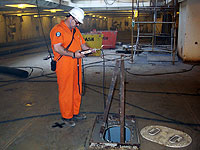Shipyard Employment eTool
Hot Work (including Welding, Cutting and Heating) » Hot Work in Confined Spaces
Fire Watches, Establishing Rescue Teams, Ventilation, Warning Signs and Labels, and Hot Work
Due to the unique hazards associated with hot work in confined spaces, additional controls are required. The following include specific requirements for hot work in confined spaces:
- Hot work operations in confined spaces
- Fall hazards
- Ventilation requirements
- Fire prevention requirements
- PPE requirements
The Confined or Enclosed Spaces and Other Dangerous Atmospheres module should be reviewed before continuing with this section. Also, the module outlining the requirements for Hot Work in Enclosed Spaces should be reviewed before reviewing the module regarding Other Locations, or these requirements for Confined Spaces.

Potential Hazards
Due to the isolation and difficulty of egress, hot work operations in confined spaces present additional hazards. These include:
- Impeded egress from the space under emergency conditions
- Undiscovered worker injury and delay of treatment.
Requirements and Example Solutions
- Provide, if possible, more than one means of access to the space. [29 CFR 1915.76(b)]
- Keep access to the space clear. [29 CFR 1915.51(c)]
- Employees working alone in a confined space must be checked on at regular intervals (29 CFR 1915.84(a)).
Potential Hazards
Fall hazards are a leading cause of shipyard fatalities. Shipyard employees are often required to work in dangerous environments that may include fall hazards. Accidents involving elevation equipment such as ladders, scaffolds, and aerial lifts are often serious, even fatal. Workers also risk falls from open deck edges.
Requirements and Example Solutions
Guarding of Deck Openings and Edges
- Openings and deck edges must be guarded. [29 CFR 1915.73]
- Flush manholes and other small openings must be guarded after opening. [29 CFR 1915.73(b)]
- During the installation of guards on large openings and deck edges, fall protection (harness with lanyard) must be used. [29 CFR 1915.73(d)]
- When floor plates or gratings (e.g. bilges, engine rooms, pump rooms, machinery spaces) are removed, the openings must be guarded or planked. [29 CFR 1915.73(f)]
Fall Protection for Scaffold Work
- Guardrails or other appropriate fall protection must be used when working on scaffolds 5 feet above surfaces. [29 CFR 1915.71(j)]
- During the installation of guards on scaffolds, fall protection must be used. [29 CFR 1915.73(d)]
- SHAC recommends that personal fall protection including lanyards and harnesses be used and secured during installation of guardrails and erection and dismantling of scaffolds.

Potential Hazards
Confined spaces usually do not have adequate natural ventilation, which may expose workers to hazardous fumes and gases.
Requirements and Example Solutions
- Use adequate mechanical ventilation or airline respirators for hot work in confined spaces. [29 CFR 1915.51(b)]
- Keep access clear of blockage from ventilation equipment. [29 CFR 1915.51(c)]
- If the ventilation equipment blocks access to the space, airline respirators as well as a stand-by employee must be available. [29 CFR 1915.51(c)(3)]
See the Confined or Enclosed Space Entry and Other Dangerous Atmospheres for additional information regarding ventilation.

Potential Hazards
Because confined spaces have little natural ventilation, flammable gases may accumulate to hazardous levels, even when unoccupied, exposing workers to risk of fire or explosion upon re-entry.
Requirements and Example Solutions
Work in confined spaces requires certain restrictions regarding what equipment can be taken inside and what equipment can be left inside when unoccupied.
- Torches and hoses must be removed from confined spaces when not in use (lunch breaks, shift changes, etc.). [29 CFR 1915.503(b)(2)]
- Oxygen and fuel gas cylinders must not be taken into confined spaces. [29 CFR 1915.55(b)(4)]
- For additional requirements, see the Fire Protection chapter.
See the Confined or Enclosed Space Entry and Other Dangerous Atmospheres for additional information regarding ventilation.


